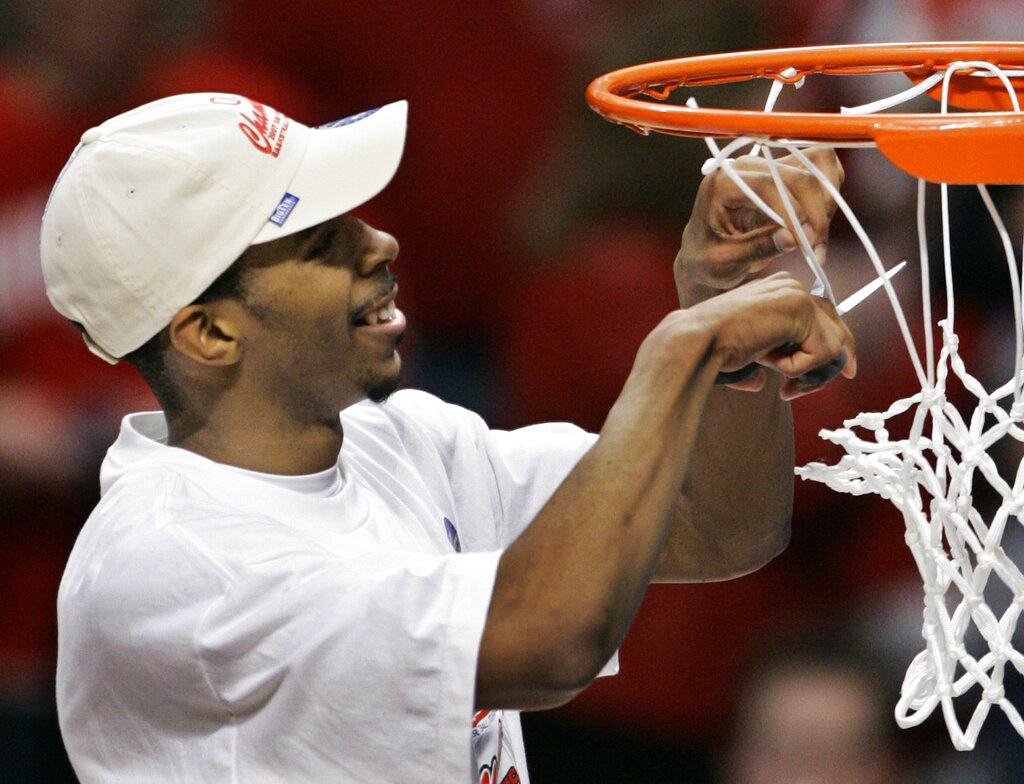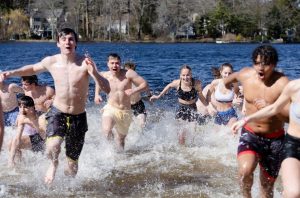
Conley’s Corner: Made in March
Editor’s note: Mike Conley is one of the best sources of information in the NBA.
Entering his 17th NBA season, the 36-year-old Timberwolves point guard has seen it all and has the knowledge and willingness to explain what’s taken place and what’s to come with the media and, thus, the fans. That breadth of insight and analysis extends from the on-court Xs and Os to team dynamics and development.
Conley is just as good at explaining why two teammates came to blows in the middle of a timeout as he is on what the team needs to do to decode a switch-heavy defense.
So who better to sit down with twice a month to tackle different topics ranging from the Timberwolves to the NBA at large to, well, Mike Conley, than Conley himself.
This is the ninth installment of Conley’s Corner.
MADE IN MARCH
Mike Conley religiously watches back every single game he plays shortly after the contest has concluded.
It’s a routine that’s dated back years and years. In the “old days” he’d get the film of the game copied onto a DVD. Now, it gets sent to his phone as soon as the game is over. Win or loss, good or bad, he watches.
With the exception of one.
He has never rewatched Ohio State’s loss to Florida in the 2007 National Championship game.
“I still can’t go back and watch any of that game,” Conley said. “I get sick to my stomach. It hurt. It hurt a lot. I remember it like yesterday, but I cannot get myself to watch it. One day, I’ll get over it. But it’s just a tough one.”
Credit to Conley, that’s actually the game he thinks about the least in his magical run through March as a freshman guard at Ohio State.
The game he thinks most about is the one featuring the shot that altered the course of his entire career – and he wasn’t even the one shooting the ball.
Top-seeded Ohio State was trailing in-state rival Xavier by two with nine seconds to play when star center Greg Oden had to foul Justin Cage on a rebound after a missed Buckeyes’ shot.
Oden fouled out and Ohio State was on the brink of elimination.
Cage hadn’t missed from the field all day, and was 5 for 6 from the stripe as he approached the line. He buried the first free-throw. One more make and the Buckeyes were effectively eliminated.
“We honestly didn’t expect him to miss a free throw,” Conley said.
But the second attempt rimmed out. New life was granted to the Buckeyes. But they had to act, and fast. Ivan Harris grabbed the rebound and Conley raced to get the ball. It was go time.
Today, you’d expect nothing less than Conley – one of the NBA’s premier floor generals – to manufacture a brilliant game-tying look.
But in 2007, he was a freshman point guard playing in his first NCAA Tournament. The pressure of the single-elimination bracket reduces countless high-end young players to rubble. March Madness is equal parts “What a play!” and “What was he thinking?”
Ohio State didn’t have a timeout. There was no play call. The fate of a historic season was purely in the hands of a 19-year-old.
“Coming down the court, I was looking up, surveying to see where everybody was at,” Conley said. “I’m thinking, ‘I’m not trying to shoot this,’ because I’m not a big shooter like that. I’m looking for anybody else.”
Conley was at a jog as he came down the floor. Then he noticed Ron Lewis trailing to his left. Lewis had already buried three triples in the contest. His offense kept Ohio State in the game.
“Oh yeah,” Conley thought. “This is my guy.”
Conley stopped, meandered to the middle of the floor and pitched the ball to Lewis. Then the guard turned his body to firmly plant himself in front of Lewis’ defender to give the shooter space.
“It’d be an illegal screen nowadays,” Conley admitted.
Not in this situation. Not with a tournament game on the line. Lewis rose and fired.
Bang. Tie game.
“When it went in I remember celebrating, looking at him and like staring and flexing,” Conley said. “Then realizing there was like a second left and I turned back around and tried to find somebody and make sure they didn’t heave a half-court shot.”
To overtime they went.
“Yeah, that was a crazy moment,” Conley said. “It was guys just instinctually going through it, and it worked.”
So, how did that shot alter Mike Conley’s career?
“It changed it in every way, honestly,” Conley said. “I think, had he not made that shot, I’m coming back to school.”
Instead, Conley’s stock skyrocketed, starting with the ensuing overtime period. He scored 11 points in the extra stanza to guide Ohio State to victory. And a new Conley was unleashed.
Conley certainly would’ve been a first-round pick had he chosen to come out even if the Buckeyes lost to Xavier. But it wasn’t clear at that point exactly what he’d become.
He scored in single digits in 16 of Ohio State’s 28 regular season games. He had just four points on five shot attempts in the Buckeyes’ first-round NCAA victory over Central Connecticut State.
The guard was the Buckeyes’ offensive maestro all season, but he hadn’t displayed much offensive aggression until it was required to beat Xavier. A switch was flipped.
“It gave me a lot of confidence. My teammates gave me a lot of confidence. I’ve always been a reserved guy and just let everybody else do their role – like, if you’re a scorer, you can score 30 and I’ll be the guy that sets him up. That’s just my nature,” Conley said. “But, from that point on it was like, ‘Nah, Mike, we need you to be aggressive and score. You see what happens when you do that, we win against good teams, we come back in big games.’ So I just started building off of that, and each game I just felt like I got better and better and more adventurous as a player trying new things and being creative and it kind of started that whole shift in that mindset.”
Conley averaged 11 points on the season. The rest of his tournament run went as follows:
Sweet 16 against Tennessee: 17 points, seven rebounds, six assists and two steals to rally Ohio State back from down 20 in a game in which Oden played just 18 minutes.
Elite 8 against Memphis: 19 points, four rebounds, two assists and two steals.
Final 4 against Georgetown: 16 points, six assists and five rebounds.
Championship game against Florida: 20 points, six assists and four steals.
Domination.
With each passing performance, Conley’s draft stock soared, as evidenced by DraftExpress write-ups.
In January of that season, Conley was compared with Dominic James, who never played an NBA game. After the Xavier game it was “too early to decide” whether or not to come out. After the Tennessee game, “any doubts that Conley would be considered one of the top two or three point guards in the 2007 draft if he decided to throw his name in the mix ended as time expired.”
After the Memphis game, the site wrote that “he would still be well-served to return to school for his sophomore year” but added the debate for top point guard was between Conley and Ty Lawson.
After the Final 4 win, the site said Conley ranked as one of the top guards in the draft and noted it “would be very tough to see Conley falling very far in the first round should he declare, and the lottery wouldn’t be out of the picture, either.”
Conley tracked none of that during his March Madness run. He was engulfed in the moment. Part of the reason Conley and Oden chose Ohio State was because it was a program on the rise that hadn’t yet experienced championship-level success. Being a part of such a run at a traditional football school was a blast.
“Honestly, it was the most fun time of my life. It’s amazing, because you travel to whatever city you’re playing in, you play your two games. You win, you get to go back to school and school is going crazy for two, three days. You’re walking around and it’s all about the tournament, next game and all you’re thinking about is the next chance you get,” he said. “Then you’ve got to travel again, and you get to the next city, and as young guys, this is your first experience being in like the Alamodome or something like that – the Georgia Dome – big places, big arenas and then coming out with comeback wins, 21-point deficits, you win off a blocked shot, you win off a Ron Lewis game-tying three. It’s a lot. So after every game, you’re just exhausted from pure adrenaline, excitement. It just carries on and builds as you keep going further and further, the excitement from the student body and the fans around the globe.”
Frankly, after the loss to Florida, he was ready to make another run at it. He loved everything about Ohio State, and was in no rush to leave. He made lifelong relationships there. But in the days after the defeat, Buckeyes coach Thad Matta called the point guard into his office and said it was time to think about the NBA.
Conley was taken aback.
“I was like, ‘The draft? I’m not even thinking about the NBA. That’s Greg Oden, that’s Daequon Cook, that’s these other guys.’ I’m like, ‘I’m just Mike. I’m not the guy,’” Conley said. “He’s like, ‘No, you don’t understand. After the tournament, you (skyrocketed).’ It’s like, ‘No way.’ So I started calling my dad like, ‘Is this true?’ Kind of looked it up and saw that, all of a sudden now, I’m projected to be a lottery pick. And Thad was like, ‘Man, you’ve got to go. You can’t miss out on these opportunities.’ That’s the kind of coach he was, and still is. He looks out for his players.”
Conley – who during his tournament run said he was going to return to school – quickly realized there wasn’t much of a decision to make. It was time to go.
He didn’t just go in the first round. He didn’t just go in the lottery. He went No. 4 overall to Memphis, where he became a Grizzlies legend and started his outstanding NBA career.
And he has Ron Lewis to thank.
Had that shot not fallen, Conley likely does return to Ohio State, where he would’ve played alongside the likes of Evan Turner, Jon Diebler and Kosta Koufos. Perhaps Conley eventually would’ve reached the same heights a year later.
“You just had a bunch of really good, talented players coming, so … I think we would’ve been really good,” Conley said. “I don’t know what my role would’ve been. Might’ve tried to be a scorer then instead of an in-between, bounce kind of guy. I don’t know how I would’ve fared doing that, knowing I’d never done that before at a high clip.”
There’s also no guarantee that Conley would’ve been drafted as high or went to the proper situation a year later. For instance, Lawson ended up returning to school that offseason after a poor showing in the NCAA Tournament. He won a national title as a junior at North Carolina, but was drafted No. 18 overall after his junior campaign and spent eight years in the NBA.
Not bad by any stretch, but not Mike Conley.
“Without (Lewis’ shot), I think I could easily have been back in college. And you never know, you go another year, you get hurt, you win a national championship. Things could change, but you just never know,” Conley said. “I think that moment was significant for me, and I’ve told (Lewis) that before, many times.”
Oh, and, if you’re wondering in which months Mike Conley sports his highest points per game and field goal percentage numbers in his NBA career — yeah, it’s March and April.
Related Articles
Timberwolves wax Denver to reclaim top spot in Western Conference
Marc Lore, Alex Rodriguez say they’ll be the owners of the Timberwolves despite Glen Taylor’s statement
Glen Taylor says Timberwolves, Lynx no longer for sale
Rudy Gobert dominant again as Timberwolves pull away from Detroit for 50th win
Timberwolves celebrate news of T.J. Warren’s signing for rest of season


